What is Conversational Commerce? Definition & Detailed Guide

What’s Inside
- What is Conversational Commerce?
- Why is Conversational Commerce Important?
- How Does Conversational Commerce Work?
- What Are the Types of Conversational Commerce?
- What are the Advantages of Conversational Commerce for Brands & Customers?
- What Are the Challenges to Conversational Commerce?
- What Are the Key Statistics on Conversational Commerce?
- What Are the Industrial Use Cases of Conversational Commerce?
- What Are the Best Practices to Optimize Your Business for Conversational Commerce?
- What is the Future of Conversational Commerce?
- Conclusion
key takeaways
- Conversational commerce merges AI and chat platforms to create interactive shopping experiences.
- It offers personalized assistance and facilitates seamless transactions, enhancing customer service.
- Businesses can build stronger customers relationships by understanding their preferences through conversational data.
- The future of conversational commerce is promising, with advances in AI technology. This will make interactions more intuitive and personalized.
- Implementing conversational commerce requires understanding your audience, choosing the right platform, and optimizing for voice search.
What is conversational commerce? How has it reshaped the way customers interact with the business?
Conversational commerce is a new trend where chatting helps shape the customer experience and in turn helps the business succeed. It's becoming a crucial part of online shopping.
Companies use conversational commerce platforms to get to know their customers better and improve their online experience. It combines online shopping with chatting, making it easier for online and physical stores to work together.
Our research shows that 60% of brands consider private or direct messaging as essential to their customer service strategy.
By exploring its diverse aspects, businesses can build better relationships with their potential customers and stay ahead in their industries.
What is Conversational Commerce?
Conversational commerce definition - Conversational commerce can be defined as using AI to make personalized shopping experiences more interactive. It's a way to use chatbots or other mediums to help customers shop without going through a website.
This method is excellent for getting quick answers, buying items quickly, and giving suggestions based on your customer’s preferences.
The more a business knows about what its customers buy and like (commerce data), the better these AI-driven personalized conversations can be.
One of the most amazing examples of conversational commerce podcast is by Stephanie Griffith and Matt Lady on Spotify. Their perspective towards this topic is insightful.
Why is Conversational Commerce Important?
Conversational commerce enhances the customer experience by facilitating seamless interaction between businesses and customers. This is possible through conversational commerce platforms like chatbots and social messaging apps.
This approach simplifies shopping, providing personalized assistance and instant support directly where customers spend their time online.
When a business knows what you buy and like, it can use that information to improve AI-driven conversations.
For example, if a store knows you love hiking, they can recommend outdoor gear when chatting with you online. This helps the conversation feel more personal and valuable to the customers.
So, the more a business knows about customers’ preferences, the more helpful and relevant their AI-driven conversations can be.
The importance of conversational commerce lies in its ability to improve engagement and sales for businesses. It makes shopping more convenient and tailored for consumers.
Now that you understand the meaning of conversational commerce let's delve deeper into how it works.
How Does Conversational Commerce Work?
Conversational commerce functions through these steps:
- Customers start a conversation with a business via messaging apps or chat platforms.
- Businesses respond promptly using chatbots or human agents to engage customers.
- Businesses provide information and recommendations on products or services.
- Chatbots or agents address customer queries and concerns in real-time.
- Customers complete purchases directly within the messaging platform.
- Businesses may follow up with customers to ensure satisfaction and provide updates.
Let’s explore the types of conversational commerce channels.
What Are the Types of Conversational Commerce?
Conversational commerce leverages various channels to enhance the eCommerce customer experience. It facilitates seamless interactions between businesses and consumers.
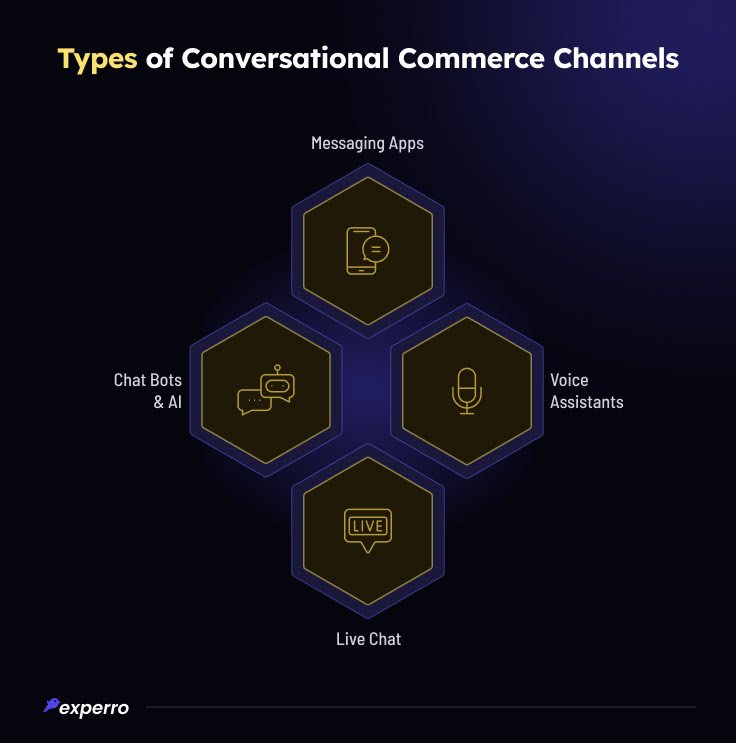
Here are the different types of conversational commerce:
Messaging Apps
These are at the forefront of chat commerce, offering a direct line between customers and brands. Popular conversational commerce apps include WhatsApp, Facebook Messenger, and WeChat.
These apps enable businesses to send personalized messages, updates, and support, illustrating an example of conversational commerce in retail and beyond.
Voice Assistants
Devices powered by voice assistants like Amazon Alexa and Google Assistant represent the future of digital commerce. This lets users shop, inquire about products, and control smart devices through voice commands.
This AI conversational commerce channel redefines the customer journey by making it more accessible and hands-free.
Live Chat
Live chat offers real-time assistance to shoppers. It combines the immediacy of conversation with the personal touch of human interaction. This makes it a vital conversational commerce tool for enhancing online shopping.
Chat Bots & AI
Chatbots and AI-powered search automate customer service and sales tasks. They can handle various inquiries, from basic questions about store hours to complex product recommendations. These bots are designed to understand and respond to customer needs anytime.
Each of these channels contributes to a robust conversational commerce strategy. This offers diverse ways for brands to connect with their audience. By integrating these technologies, companies can create a more personalized and engaging shopping journey.
Now, coming to the advantages of conversational commerce for businesses and customers.
What are the Advantages of Conversational Commerce for Brands & Customers?
Conversational commerce bridges the gap between brands and customers by offering an interactive platform. Here, every customer interaction is personalized, fostering a sense of being understood and appreciated.
This approach not only nurtures customer loyalty beyond mere transactions but also delivers mutual advantages for both businesses and their clients.
In the following sections, we'll delve into the specific benefits it provides to the brands and customers.
Benefits of Conversational Commerce for Brands
For brands, the shift to conversational commerce is a strategic move that humanizes the digital shopping experience and boosts brand management:

- Higher Conversion Rates: It helps engage customer communication that feels more personal. It also effectively guides them through buying, leading to higher sales.
- Enhanced Customer Engagement: Each interaction is an opportunity to learn more about your customers, understand their needs, and instant responses in real-time, deepening the relationship.
- Operational Efficiency: By automating routine inquiries, brands can focus their human talent on complex issues and strategic initiatives. It helps improve overall efficiency and boost customer satisfaction.
- Rich Customer Data: Conversations offer a deeper understanding of customer preferences and behaviors. It can help you know more about product development and marketing strategies.
- Competitive Advantage: In a crowded marketplace, the ability to offer a personalized, conversational experience sets brands apart. This helps align with the evolving expectations of modern consumers.
While retailer commerce offers numerous benefits, it also presents challenges that should be considered carefully before selecting a platform.
Benefits of Conversational Commerce for Customers
Conversational commerce isn't just about technology; it's about crafting meaningful, human-centered experiences.

Here's how it benefits customers:
- 24x7 Support: Imagine having a helpful assistant available anytime, ready to answer your questions or solve problems. 24x7 support accommodates everyone, making it easier for customers to get help at a time that suits them best.
- Convenience: Conversational commerce brings shopping into the spaces where customers spend their time, like Facebook Messenger and social media applications. This makes buying as simple as sending a text or a voice note.
- Personalized Experiences: Each customer is unique, and conversational AI commerce excels at providing tailored advice and product recommendations. It's like walking into your favorite store and being greeted by name with suggestions just for you.
- Ease of Use: The intuitive nature of conversational interfaces reduces the complexity of online shopping. There's no need to navigate endless menus - ask, and you will find.
- Seamless Transactions: Completing a purchase becomes a part of the conversation. It removes barriers and makes the process smoother and more enjoyable.
What Are the Challenges to Conversational Commerce?
As conversational commerce offers a seamless blend of messaging and shopping, businesses find unique challenges.
Understanding these hurdles is crucial for companies aiming to leverage conversational commerce platforms.
Here's a closer look at these challenges and their potential for transforming customer interactions.
1. Understanding Natural Language
The complexity of natural language, with its nuances, idioms, and slang, presents a significant challenge. Conversational commerce chatbots and AI must accurately interpret and respond to customer queries.
2. Maintaining Privacy and Security
As conversational eCommerce uses personal and payment details in chats, keeping these conversations private and secure is very important.
Conversational commerce companies must implement robust security measures to protect valuable customer data. It's a responsibility that grows alongside the conversational commerce market size.
3. Integration with Existing Systems
It must integrate seamlessly with a brand's existing systems — from inventory management to customer relationship management (CRM).
This integration allows for a unified and positive customer experience. But it can be complex, resource-intensive, and challenging, especially for enterprise conversational commerce.
4. Developing a Conversational Commerce Strategy
Crafting an effective conversational commerce strategy involves more than just leveraging technology. It requires a deep understanding of customer needs, behaviors, and preferences.
A conversational commerce software must be designed to engage and encourage customers meaningfully. This also requires ongoing analysis and adaptation based on conversational commerce statistics and trends.
5. Balancing Human Touch and Automation for Customer Satisfaction
Maintaining a human touch and natural language processing (NLP) is essential for specific interactions. Determining when a customer should be directed from a conversational eCommerce chatbot to a human agent is a delicate balance.
As businesses navigate these challenges, the future of conversational commerce looks bright, with advancements in AI and machine learning.
It is continually enhancing the sophistication of conversational commerce tools. The potential benefits for customers and brands are immense, from personalized shopping experiences to improved operational efficiency.
What Are the Key Statistics on Conversational Commerce?
Conversational commerce is changing shopping and customer service; the numbers show it's becoming more popular.
The increasing adoption underscores the value both consumers and businesses find in these interactive platforms.
This makes shopping faster and smoother in the competitive conversational commerce market. This is a direct plus for customers and an indirect plus for companies.
Let's look at some vital stats that explain why this trend is taking off.
Projected Expansion in Conversational Commerce Investments
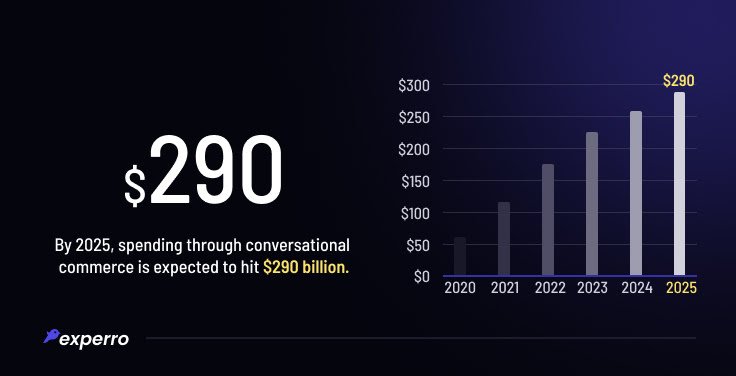
By 2025, people are expected to spend $290 billion through conversational commerce.
This shows more people enjoy shopping through chat and voice services, and companies are putting money into making these options better for everyone.
Customers Pay More for Good Experiences
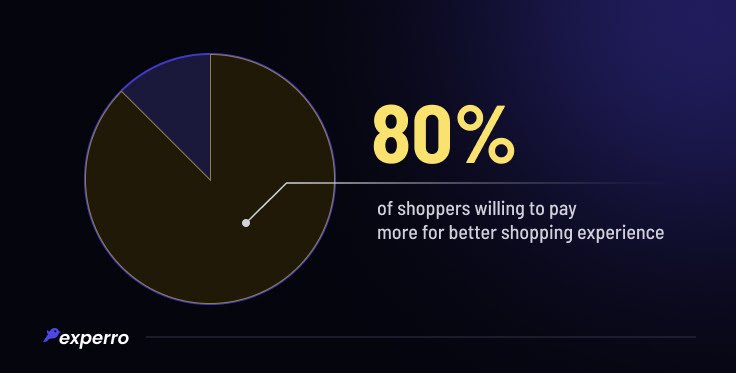
A survey found that 80% of people would pay more if it meant they could get a better shopping experience.
This means how a brand treats customers can be more important than the price or the product itself.
More Users on Messaging Apps Than Social Media
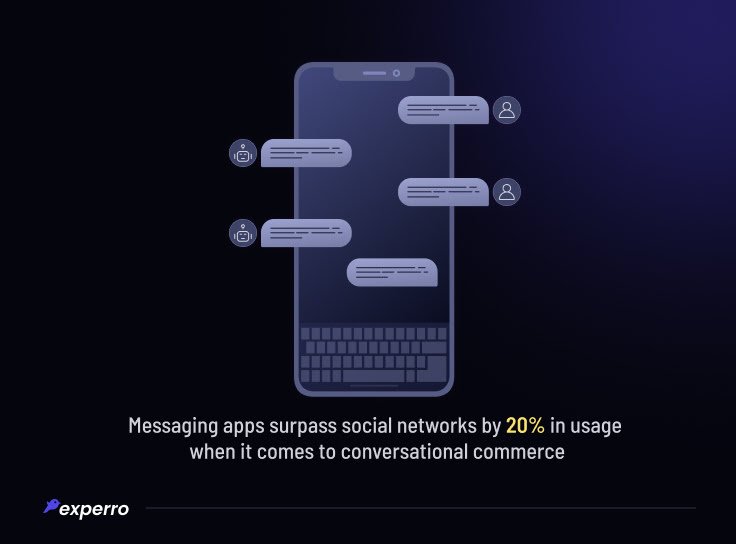
Nowadays, 20% more people use messaging apps than social networks.
This change shows that messaging apps are increasingly crucial for businesses to directly communicate with customers and meet their needs.
Buying with Chatbots

Surprisingly, 47% of survey respondents expressed openness to purchasing through chatbots.
This openness to bot-assisted shopping signals a shift in consumer trust and perception towards AI-driven commerce. It shows that people are starting to trust and feel comfortable using chatbots to shop, ask about delivery, or get refunds.
Now, let’s find out conversational commerce's functional and industry-specific use cases.
What Are the Industrial Use Cases of Conversational Commerce?
Conversational commerce is transforming the way we interact with businesses. It makes the process more like conversing with a friend rather than a transaction.
Here's a deeper dive into conversational commerce use cases across various sectors:
- Retail Personalization: Imagine chatting with a bot that knows your taste and preferences. This offers product suggestions that feel handpicked for you and make online shopping convenient and delightful.
- Banking Made Simple: Securely check your finances, get spending alerts or even receive personalized financial advice through a conversation. This makes managing money less of a chore.
- Travel Made Easy: Plan your trips easily, get suggestions, book travel and accommodations, and receive real-time updates if anything changes. Everything can be done within the comfort of your messaging app.
- Educational Engagement: Students can get help with homework, access study materials, or communicate with educators more engagingly and immediately. This makes learning more interactive.
Conversational commerce startups are more than just convenience. It's about creating a seamless, engaging, and personalized way for customers to interact with businesses.
We can expect even more innovative uses and benefits as conversational technology evolves.
Before that, you must learn the best practices to optimize your business for conversational commerce. Let’s learn them.
What Are the Best Practices to Optimize Your Business for Conversational Commerce?
Businesses must follow a set of best practices to make the most of conversational commerce.
This approach doesn't just involve using chatbots or AI; it's about creating a seamless, engaging shopping experience for your customers.
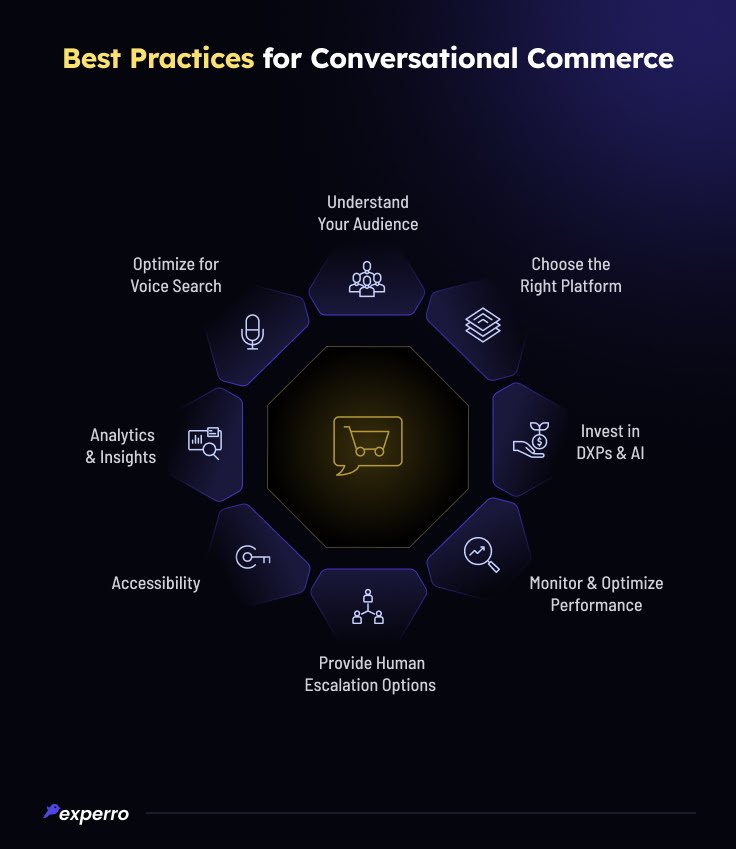
Here’s how you can optimize your business for conversational commerce:
Understand Your Audience
It is crucial to know who your customers are, what they need, and how they prefer to communicate. This insight helps tailor conversational commerce solutions to meet their expectations and enhance the customer journey.
Choose the Right Platform
Not all conversational commerce platforms are the same. Whether it's messaging apps, social media, or voice assistants, select the one where your customers are most active to maximize engagement.
Invest in DXPs & AI
Digital Experience Platforms (DXPs) and Artificial Intelligence (AI) are the backbones of effective conversational commerce.
They power conversational chatbots and AI solutions that can handle inquiries, offer personalized recommendations and learn from customer interactions.
Handpicked for you! - 5 Best Digital Experience Platforms to Choose From!
Monitor and Optimize Performance
Use analytics and insights to understand how your conversational tools are performing. Look at conversational commerce statistics to identify areas for improvement. Ensure your strategy evolves with customer needs.
Provide Human Escalation Options
Conversational commerce AI and chatbots can handle a lot, but a human touch is sometimes needed. Ensure customers can easily switch from conversational commerce bots to speaking with a person when complex issues arise.
Accessibility for Better Customer Engagement
Your conversational commerce platform should be accessible to everyone. This inclusivity ensures a broader audience can benefit from your services.
Optimize for Voice Search
With the rise of voice technology in conversational commerce, optimizing for voice search is more important than ever. Make sure your content and offerings are easily discoverable through voice queries.
By implementing these practices, businesses can enhance their conversational commerce experience. This approach not only meets the current trends but also positions your brand for success.
The future of customer interaction lies in making these experiences as easy, natural, and personalized as possible and conversational commerce leading the way.
Let's delve into the future trends and evolving landscape of conversational commerce.
What is the Future of Conversational Commerce?

The future of conversational commerce is set to revolutionize online retailers. Advancements in AI and machine learning (ML) drive it.
We'll see a more personalized purchasing journey as conversational AI commerce becomes more sophisticated to build brand loyalty.
It will enable chatbots and voice assistants to understand better and analyze customer behavior. This will lead to broader adoption across industries, making it an integral part of online shopping.
With the expansion, businesses will increasingly adopt these technologies to stay competitive. It will offer customers a seamless, engaging, and efficient personalized experience.
Conclusion
In conclusion, conversational commerce represents a significant evolution in how businesses interact with loyal customers.
By harnessing the power of AI, chatbots, and messaging platforms, companies can offer personalized, convenient, and engaging shopping experiences.
This technology simplifies transactions and deepens customer relationships through meaningful and real-time interaction.
As we look to the future, the integration of conversational commerce into retail and service sectors is expected to have significant growth. It will be driven by advancements in AI and customer demand for more intuitive and responsive shopping experiences.
For businesses, it is continuously adapting to emerging conversational commerce trends, investing in technology, and prioritizing customer satisfaction.
There are many platforms out there that offer different kinds of conversational commerce solutions.
Ultimately, the companies that best leverage conversational commerce will set new standards for customer engagement and service, shaping the future of digital commerce.
To learn more, get on a call with our team.
FAQs


Pallavi Dadhich
12 March 2024Pallavi is an ambitious author known for her expertise in crafting compelling content across various domains. Beyond her professional pursuits, Pallavi is deeply passionate about continuous learning, often immersing herself in the latest industry trends. When not weaving words, she dedicates her time to mastering graphic design.